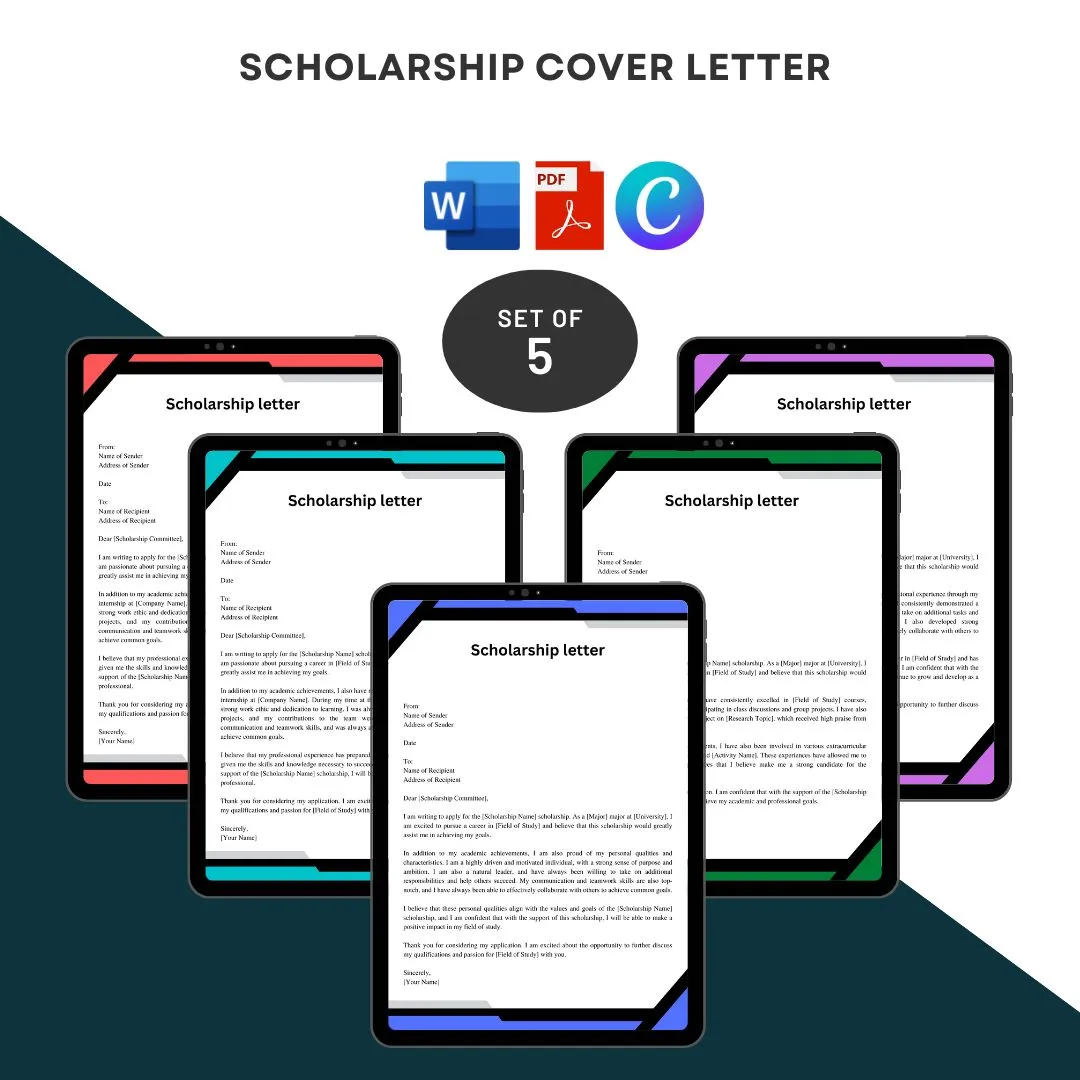What is a Scholarship Cover Letter?
A scholarship cover letter is a crucial document accompanying your scholarship application. It serves as your introduction to the scholarship committee, providing a snapshot of who you are, your academic pursuits, achievements, and financial needs. Unlike a generic application form, a cover letter allows you to showcase your personality, passion, and unique qualifications that make you a strong candidate. It’s your opportunity to create a compelling narrative that resonates with the committee and sets you apart from other applicants. A well-crafted cover letter demonstrates your communication skills, attention to detail, and genuine interest in the scholarship. It’s not just a formality; it’s your chance to make a lasting impression and increase your chances of receiving the financial aid you deserve. Remember to tailor the letter to each specific scholarship, highlighting the aspects of your background and goals that align with the scholarship’s mission.
Why is a Cover Letter Important?
A cover letter is incredibly important because it provides context to your application. It allows you to explain the ‘why’ behind your achievements, goals, and financial needs. It allows you to connect with the selection committee on a more personal level. It shows them you’re not just a name and a set of grades but a real person with aspirations, experiences, and a unique story to tell. A strong cover letter demonstrates your communication skills, an essential asset in any field. It showcases your ability to articulate your thoughts clearly and concisely, which can significantly boost your candidacy. Moreover, a well-written cover letter allows you to address any potential weaknesses in your application proactively. For example, if your GPA isn’t perfect, you can explain the circumstances that led to that, showing resilience and a willingness to overcome challenges. This can make a big difference. In essence, it is the primary way to distinguish yourself from the rest.
Key Components of a Scholarship Cover Letter
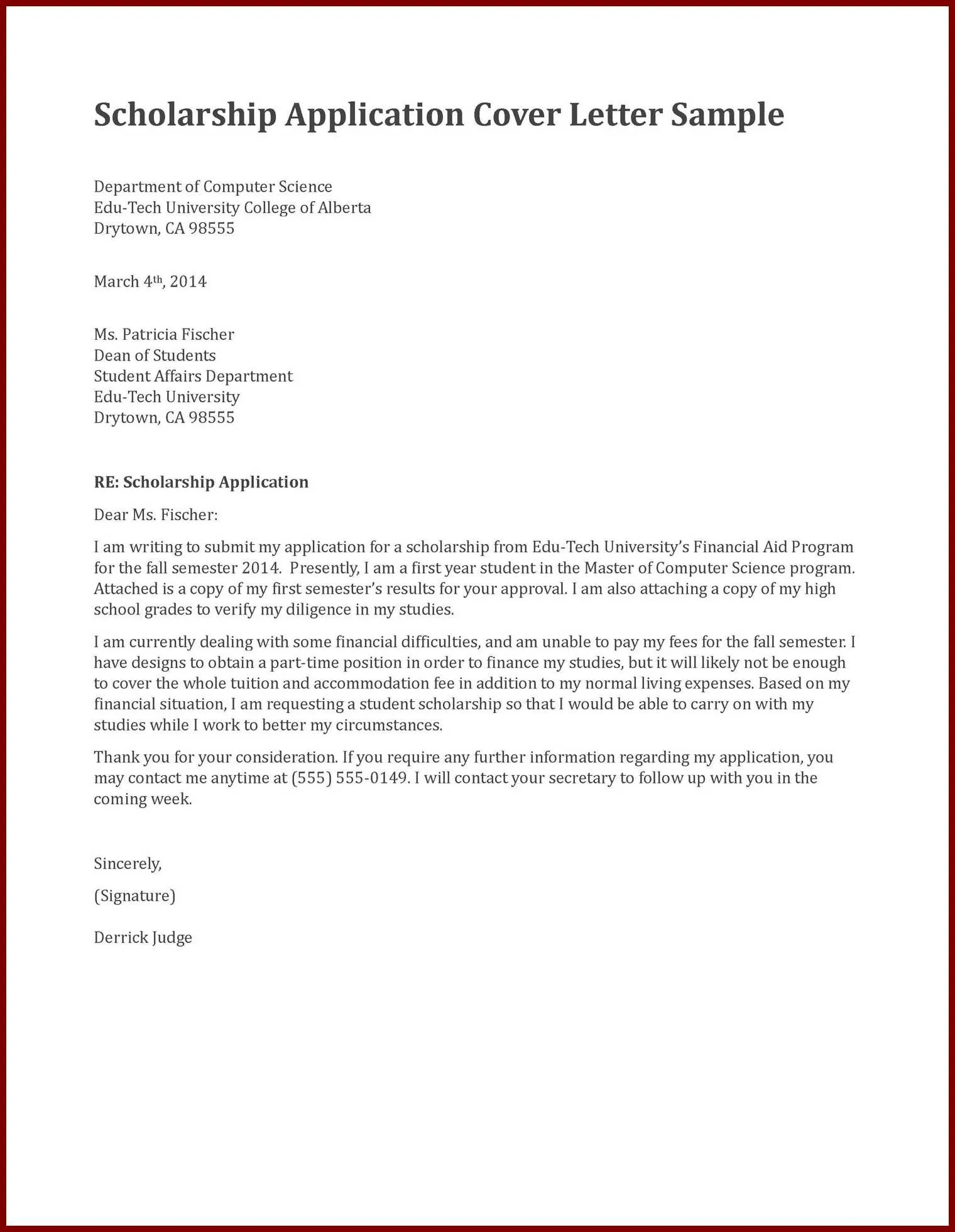
A solid scholarship cover letter is made of several key parts that, when combined, create a compelling and effective application. These components work together to present a comprehensive view of your qualifications and demonstrate why you deserve the scholarship. Each section serves a specific purpose, contributing to the overall impact of your letter. Make sure all of the sections below are well represented in your own letter.
Header and Contact Information
Begin your cover letter with a professional header that includes your full name, address, phone number, and email address. This ensures the committee can easily contact you. Also, include the date and the scholarship provider’s contact information, such as the name of the organization or the scholarship committee, and their address, if available. This demonstrates professionalism and attention to detail. Ensure that your contact information is current and professional-looking. Use a formal email address. Avoid using nicknames or informal language.
Salutation and Introduction
Start with a formal salutation, such as ‘Dear Scholarship Committee’ or ‘Dear [Name of Contact Person],’. If you know the name of a specific person on the committee, address them directly. In your introduction, state the specific scholarship you’re applying for and briefly mention why you are a suitable candidate. The introduction should immediately capture the reader’s attention and set the tone for the rest of the letter. Keep the introduction concise and focused on your main objective, which is to express your interest and qualifications. Use a compelling hook to draw the reader in, such as a brief anecdote or a statement of your aspirations.
Body Paragraph 1 Your Academic Journey and Goals
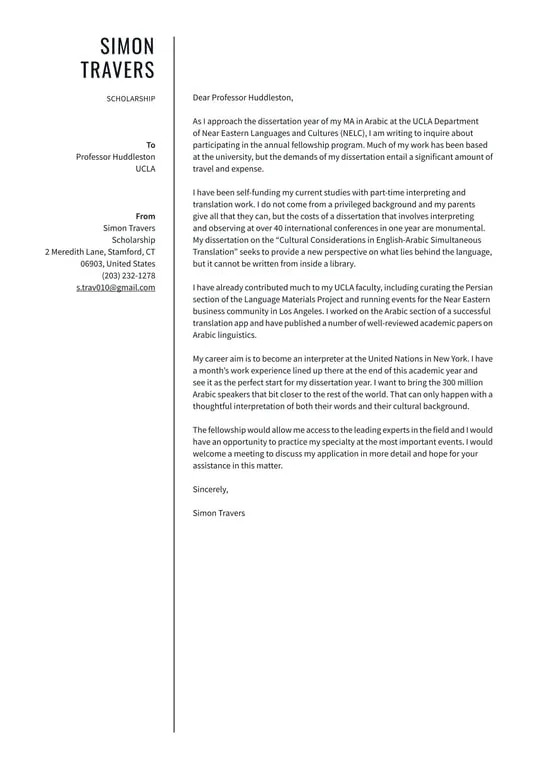
In the first body paragraph, detail your academic background, including your major, any relevant coursework, and your GPA, if it’s strong. Explain your academic goals and how this scholarship will help you achieve them. This is your chance to describe your passion for your field of study and how it aligns with the scholarship’s objectives. Show enthusiasm and be specific about your future aspirations. Link your academic pursuits to your career goals and how this scholarship is a crucial stepping stone. Highlight any unique academic experiences, such as research projects or significant academic achievements. Emphasize how your education is preparing you to make a positive impact in your chosen field.
Body Paragraph 2 Your Achievements and Experiences
Discuss your extracurricular activities, leadership roles, volunteer work, and any other experiences that demonstrate your character and skills. Focus on achievements that are relevant to the scholarship and show how you have made a positive impact. Quantify your achievements whenever possible. For example, state the number of hours you volunteered, the amount of money you raised, or the impact you had on a project. These specifics make your accomplishments more tangible. It is important to highlight your skills and qualities like leadership, teamwork, communication, and problem-solving. Show how these skills will help you succeed in your academic and professional life. It is important that you tailor this to the particular scholarship you are applying for.
Body Paragraph 3 Why You Deserve the Scholarship
Clearly articulate why you believe you deserve the scholarship. Connect your experiences, goals, and financial needs to the scholarship’s criteria. Explain how the scholarship will help you achieve your academic and career goals. Discuss how you will contribute to your community or field of study. Emphasize how you align with the scholarship’s mission and values. Demonstrate your understanding of the scholarship’s purpose and how it aligns with your goals and financial requirements. It is a good idea to show that you have done some research into the scholarship requirements.
Body Paragraph 4 Addressing any Special Circumstances
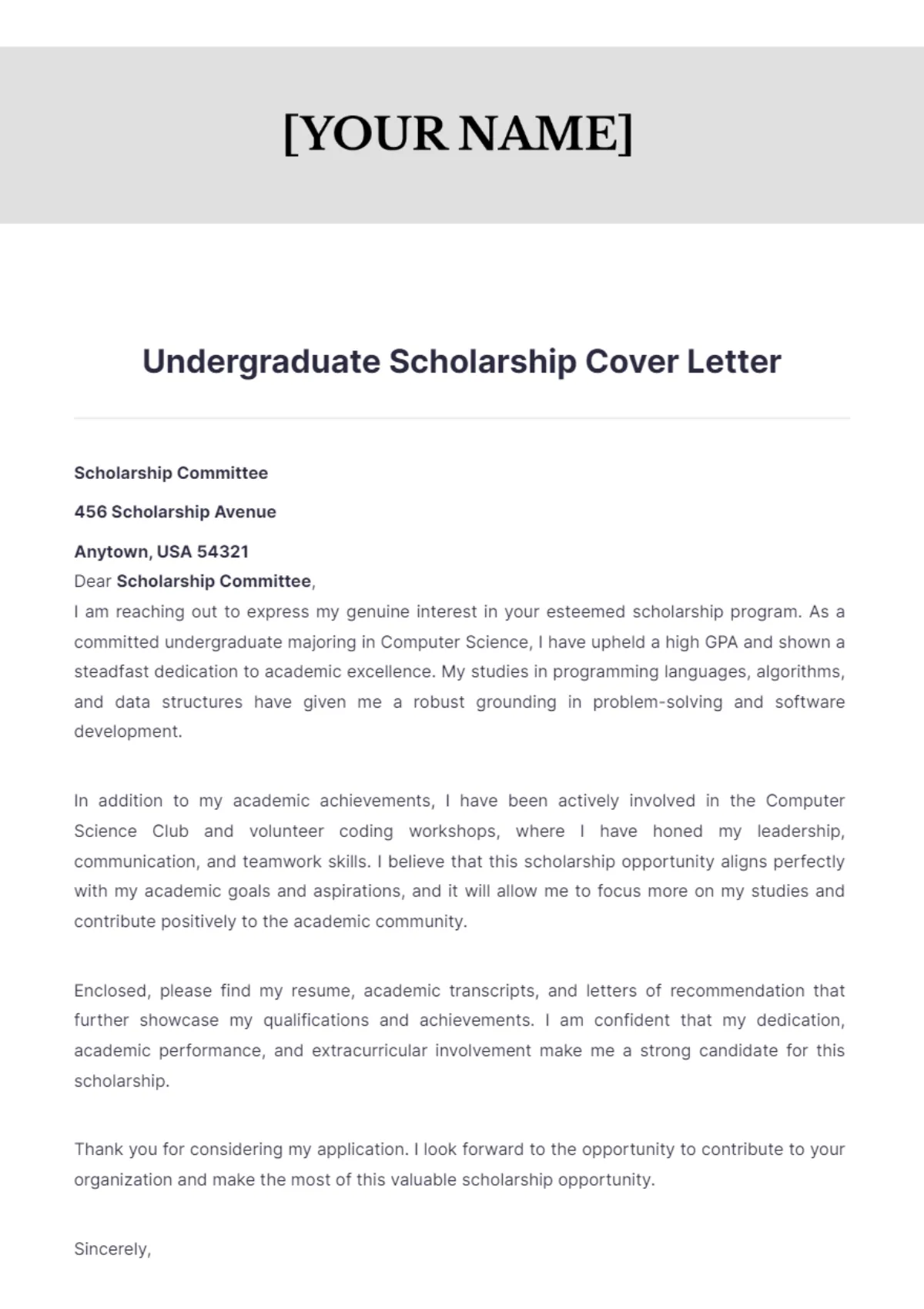
Use this paragraph to address any special circumstances, such as financial hardship, health issues, or any other challenges you have faced. Be honest and transparent, but focus on how you have overcome these obstacles. Frame your challenges as opportunities for growth and resilience. This shows the committee your ability to persevere and succeed despite adversity. If you are addressing financial needs, explain how the scholarship will alleviate your burden and allow you to focus on your studies. Ensure this paragraph aligns with the scholarship’s requirements and values.
Closing and Call to Action
Conclude your letter with a polite closing, such as ‘Sincerely’ or ‘Respectfully.’ Reiterate your interest in the scholarship and thank the committee for their time and consideration. Include a call to action. For example, you could state that you are available for an interview or provide any additional information the committee might need. Express your enthusiasm and confidence in your ability to make a difference.
Formatting and Presentation
Pay close attention to the formatting of your cover letter to ensure it looks professional and is easy to read. Use a standard font like Times New Roman or Arial in a size between 11 and 12 points. Use single-spacing for paragraphs and double-spacing between paragraphs. Be consistent with your formatting throughout the document. Maintain a professional tone and use clear and concise language. Keep the letter to one page if possible, as this demonstrates your ability to be concise. Ensure your language is free of jargon. Use action verbs to make your letter more engaging and dynamic. Proofread carefully for any grammar or spelling errors.
Proofreading and Editing
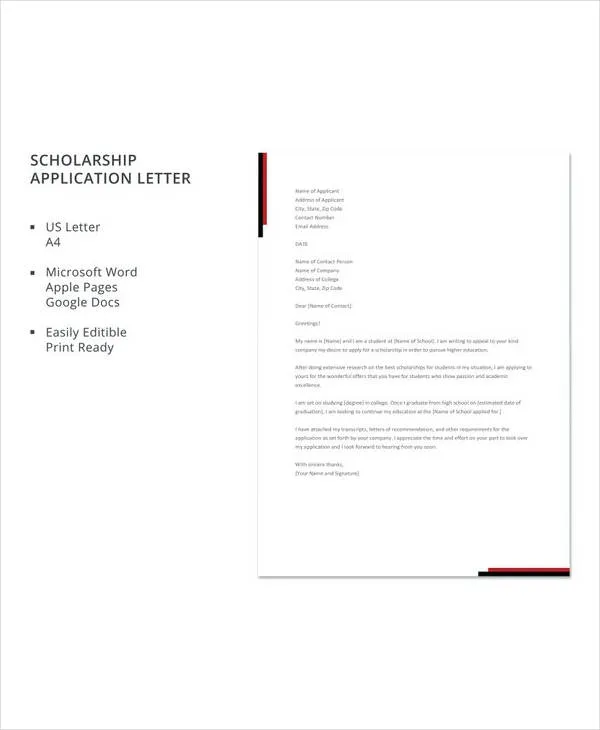
Before submitting your cover letter, proofread it meticulously for any errors. Spelling and grammatical errors can make a negative impression and undermine your credibility. Read the letter aloud to catch any awkward phrasing or sentences that don’t flow well. Ask a friend, family member, or teacher to review your letter and provide feedback. They can offer a fresh perspective and catch any errors you might have missed. Ensure the letter is tailored to the specific scholarship. Make sure your application is perfect before submission. Consider the importance of this letter to the overall application.
Cover Letter Examples
Reviewing examples can help you visualize the structure and content of a cover letter. However, always customize your letter to reflect your unique qualifications and the specific requirements of the scholarship. There are many examples you can find online.
Example Cover Letter for STEM Scholarship
For a STEM scholarship, highlight your achievements in science, technology, engineering, or mathematics. Describe your relevant projects, research experience, and any awards or recognitions you have received. Quantify your achievements using numbers, data, and results. Emphasize your passion for STEM, and your future goals in the field. Explain why your aspirations align with the goals of the scholarship.
Example Cover Letter for Arts Scholarship
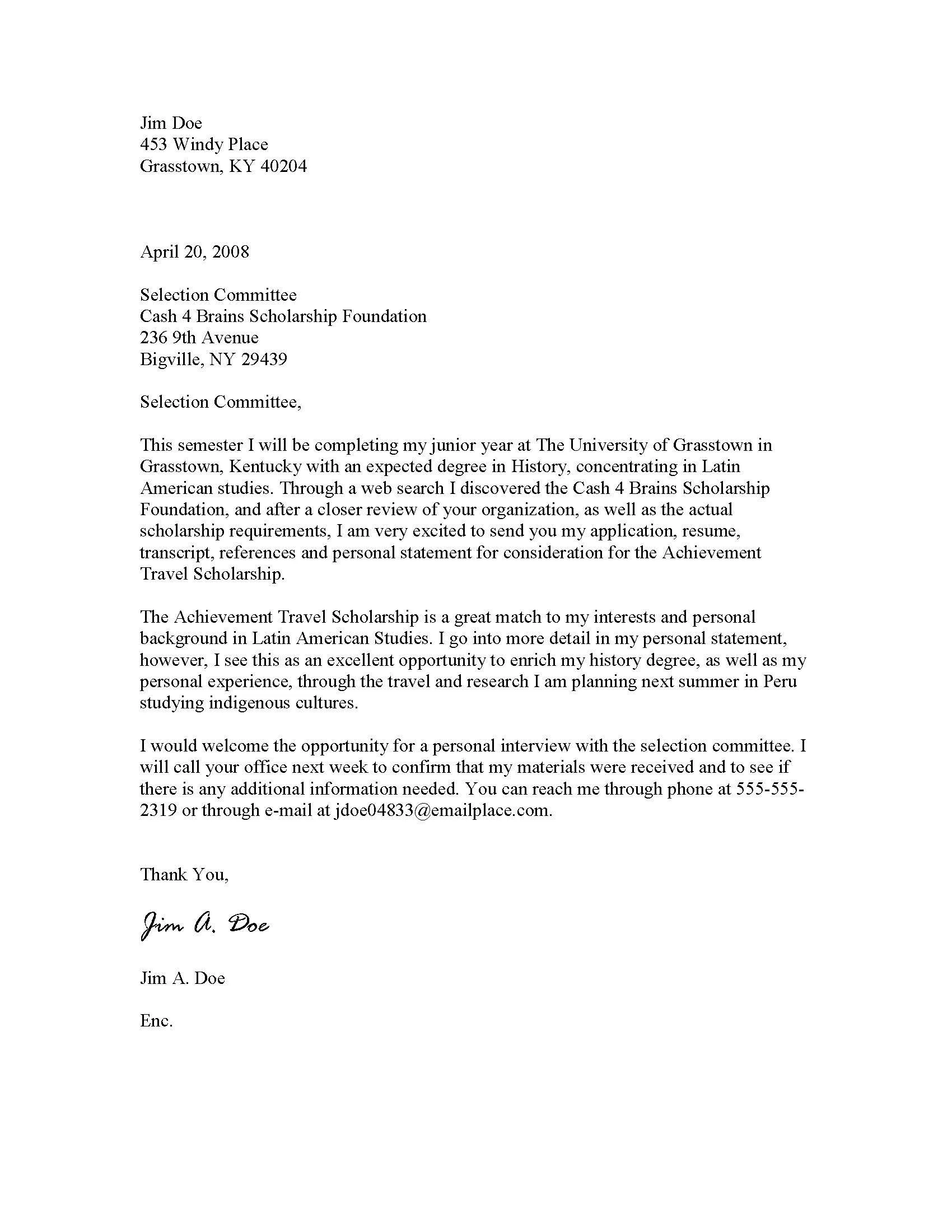
For an arts scholarship, showcase your artistic abilities, experiences, and any exhibitions or performances you have participated in. Describe your creative process, your artistic vision, and how this scholarship will help you pursue your artistic goals. Include any awards, recognition, or creative endeavors you have undertaken. Express your passion for the arts and the impact you hope to make in your field.
Example Cover Letter for Need-Based Scholarship
For a need-based scholarship, address your financial needs and explain how the scholarship will help you pursue your education. Be honest and transparent about your financial situation. Highlight any challenges you have overcome and how you have demonstrated resilience. Clearly articulate how this scholarship will enable you to focus on your studies and achieve your academic goals. Provide as much detail as is appropriate regarding your situation.
Common Mistakes to Avoid
Avoid common pitfalls that can weaken your cover letter and reduce your chances of getting the scholarship. Being aware of these mistakes will help you create a strong, compelling application.
Improper Formatting
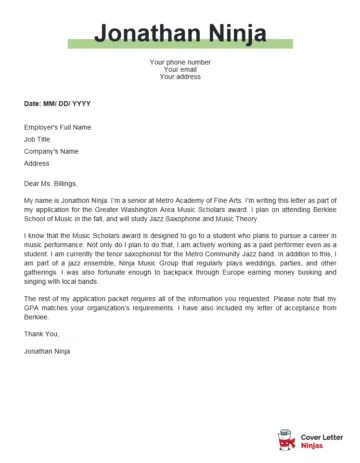
Ensure your cover letter is formatted correctly and is easy to read. Poor formatting can make your letter appear unprofessional. Avoid using a font that is difficult to read. Use clear and consistent formatting. Make sure your paragraphs are well-structured. Avoid using excessive capitalization, italics, or bolding, as these can distract from your message.
Generic Content
Avoid using generic content that could be used in any cover letter. Tailor your letter to the specific scholarship and showcase why you are a unique candidate. Don’t reuse the same letter for multiple applications without making significant changes. Show genuine interest in the scholarship and what it stands for. Highlight your specific achievements, goals, and how they align with the scholarship’s mission. Avoid using clichés and generic phrases.
Typos and Grammatical Errors
Typos and grammatical errors can make a negative impression and reflect poorly on your attention to detail. Proofread your cover letter multiple times. Ask someone else to review it for you. Use grammar and spell-check tools. Ensure your language is clear, concise, and professional. Eliminate any errors that could undermine your credibility.
Frequently Asked Questions about Scholarship Cover Letters
Here are some of the common questions regarding cover letters for scholarship.
How long should a scholarship cover letter be?
A scholarship cover letter should generally be one page long. Adhere to the length requirement, if specified by the scholarship provider.
What should I include in a scholarship cover letter?
Include your academic background, achievements, experiences, and goals. Explain why you deserve the scholarship and address any special circumstances. Highlight your skills and qualities. Always tailor your letter to each individual scholarship.
How do I make my cover letter stand out?
Tailor your letter to the specific scholarship. Highlight your unique qualifications and achievements. Show your personality and passion. Use a compelling narrative. Proofread for errors.
Final Thoughts
Crafting a strong scholarship cover letter is a crucial step in the application process. By following these guidelines, you can create a compelling letter that showcases your qualifications, aspirations, and why you deserve the scholarship. Remember to tailor your letter to each specific scholarship, highlight your unique experiences and achievements, and always proofread your work carefully. Good luck!
